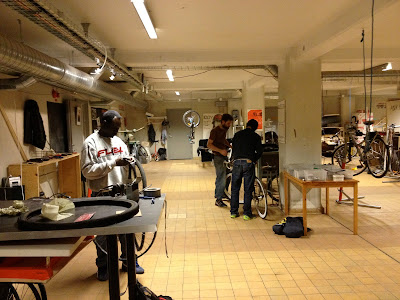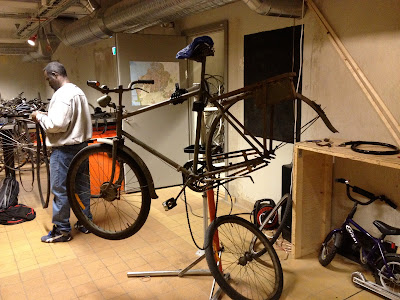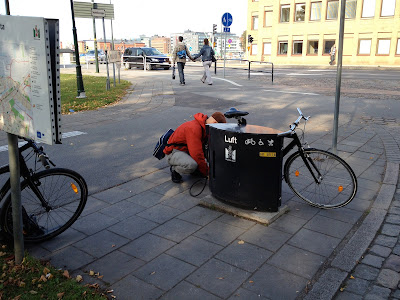another very interesting presentation at the
CLICC Conference was made by Wictoria Glad of
Linkoping University. her focus is on energy use reduction through behavioral change with a specific angle of the psychology of choice, action, and change.
Ms. Glad started with the most important, perhaps obvious, fact that people are hard to change. we are stuck in our ways and there are many reasons for that. then she delved quickly into the fact that much of energy use is not about behavior but about other factors such as physical factors (location, climate, building type, building systems, etc). she also pointed out that there are studies directly correlating energy consumption to social factors such as employment status, income, etc.
after the basics were out of the way, she got into the meat. behavior and choices are clearly linked. she cited a psychological explanation of how we choose to buy energy consuming goods and services. there is habitual (unconscious), rational (conscious), and symbolic (status). one might buy the same brand of recycled toilet paper without thinking every month from the store (habitual), but one might look carefully at buying a long lasting reusable wash cloth to replace throw away dish sponges (conscious). and then there's the symbolic prius sitting in front of your house...
then Glad started getting into some interesting explanations about choice and behavior. she talked about the opposite of economies of scale (she called it the un-economies of scale). she cited several examples about household consumption. for example, some people think that there needs to be a tv in the bedroom and one in the kitchen and one in the living room. they are all plugged in all day, wasting
phantom load (more commonly called standby power). the need to have multiples of the same thing does not end with seemingly identical items such as tvs or computers. lots of households have more than one kind of coffee maker (french press, espresso machine, etc) or toaster (toaster and toaster oven, etc). many households prepare multiple meals simultaneously (parents' dinner and baby's dinner, special meal due to allergy or health condition, etc). children of the current generation won't think it strange to have several televisions, cook several versions of the same meal, or be able to prepare an item such as toast using more than one different appliance. my parents' generation only had one (or less) tv, coffee pot, or dinner option.
Glad then talked about feedback. she explained that feedback has been proven more successful when it is easy to understand by the user, clear in content, and timely. if you want to give direct feedback to someone about energy use, here is a worst to best example:
- WORST: a yearly summation of the energy use presented in therms to the homeowner
- BETTER: a monthly update on energy use in dollars for the homeowner
- BEST: a weekly (or monthly) comparison of energy use versus last year's use and also compared with a neighbor (or neighbors)
it sounds obvious, but most people (especially in the US) get energy bills (electricity, gas, etc) in a monthly bill that does not easily translate or compare to anything else, so the information feels like it is in a vacuum. the user does not know if this is better or worse than last year or last month. changing behavior cannot be directly linked to any specific improvement. additionally, many people have changed their energy bills to be automatically deducted online, so the connection between energy use has been strained even further by technology in the 21st century.
as a conclusion to an interesting and unique presentation, Glad makes some key points. penultimately, she describes eight (8) influential factors in decision making, choice, and behavior. understanding these factors and using them to one's advantage can, she says, greatly improve the quality of the message as well as the rate of success, both of which are important in a campaign to influence people to change.
- the messenger. it's important who gives you the information and what that person's status is. is the person an authority, a friend or family member, someone with status in the community, a hero or star?
- incentives. having incentives can be useful, especially if the incentives are explicit.
- norms. these can be learned at school, work, or home. kids often learn from their parents, but there are plenty of examples where children learn about recycling at school and come home to school mom and dad...
- default. our material world (what we face every day) is, in itself, an influence. customary procedures and standards will need to be broken for change.
- salience. we are influenced by our surroundings, by beautiful things. people pay more for pretty or well designed objects (iphone, etc).
- priming. we prioritize what we talk about and we are heavily influenced by mass media and certain kinds of messages. change doesn't typically come from nothing, it is built over time through messaging and targeted communication, as well as through consensus building.
- "affects". this is really emotions. we are driven by our emotions (some more than others) not only logic. emotions can sell ideas (this is common in tv commercials for example).
- commitments. most people set some kind of goal or goals for life (sports, health, exercise, etc). some people keep these goals to themselves and others talk about them. communicating goals in an explicit fashion makes them more real, more attainable, and more likely to be reached.
- ego. we aim to better ourselves and no matter what we think, there is some piece of every person that is about an attempt to be successful. this takes many forms, but can be reinforced by simple understanding of self and desire to be what we say we are. "I take my bike to work every day."
at the end of the presentation, Glad made a simple point that is quite relevant when talking about climate adaptation, energy consumption, and aiming toward a more sustainable future. she said (this is paraphrased but pretty accurate):
"we need to design the message... maybe we should learn from other fields or parts of society. shouldn't we learn from advertising, marketing, and industries that are aimed at influence?"
Glad's presentation was intriguing to say the least. her work for Linkoping University falls into the category of "thematic studies, technology, and social change", but clearly it directly relates to issues that we are grappling with today as we aim toward a more energy conscious and sustainable future.
for more information on Linkoping University's work in this area, visit their
website.




















